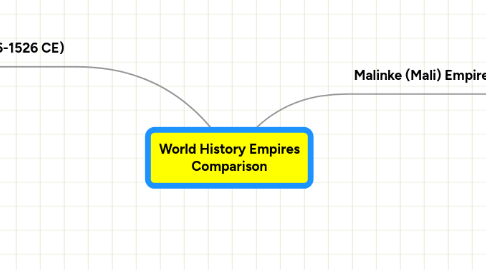
1. Malinke (Mali) Empire (1200-1450 CE)
1.1. Location
1.1.1. western Africa
1.1.2. along Niger River Valley
1.2. started by Sundiata Keita after conquering of Ghana Empire
1.3. Major Cities
1.3.1. Gao (capital city)
1.3.2. Timbuktu (important cultural and learning center)
1.3.3. Jenne (trade center)
1.4. Blending of Culture
1.4.1. Why?
1.4.1.1. willing adoption of Islam, not conquered
1.4.2. kings decided what culture to blend (depending on best interests)
1.4.3. Traditional Aspects
1.4.3.1. Cultural
1.4.3.1.1. kings still absolute and divine
1.4.3.2. Economic
1.4.3.2.1. major economic activity still farming
1.4.3.2.2. increased trade activity of gold and salt
1.4.3.3. Social
1.4.3.3.1. women still active in marketplace and economy
1.4.4. Influences from Islam
1.4.4.1. Cultural
1.4.4.1.1. Islam is state religion
1.4.4.1.2. Reinforcement of Traditions
1.5. Mansa Musa
1.5.1. hajj in 1324
1.5.1.1. world knows wealth of Mali
1.5.2. procession into Mecca on pilgrimage
1.5.2.1. took so much gold that it was devalued
1.5.2.2. took pets, wives, children, servants
1.5.3. brings back people to spread Islamic culture
1.5.3.1. new mosques built in Sahel style
1.5.3.2. Arab scholars taken to Timbuktu
1.6. Decline
1.6.1. Civil War
1.6.1.1. lower and middle classes wanted more wealth
1.6.2. Songhai Empire
1.6.2.1. led by Sunni Ali (Islamic African)
1.6.2.2. conquered Timbuktu and Jenne
2. Delhi Sultanate (1206-1526 CE)
2.1. Location
2.1.1. northern India
2.2. Invasions of India
2.2.1. India was decentralized and ruled by princes
2.2.2. 700s - Arabs in NW India
2.2.3. 900s - rebellious Mamluks create new Islamic state
2.2.4. Ghazni Turks (Afghanistan) invade
2.2.4.1. Rajputs resisted Turks
2.2.4.1.1. warriors for princes
2.2.4.1.2. battled on elephants
2.2.4.2. battled on horses
2.2.5. Ghazni and Mamluks win, establish Sultanate
2.3. Major Cities
2.3.1. Delhi (Muslim Turks power center)
2.4. Changes Forced
2.4.1. Political
2.4.1.1. centralized power in absolute ruler, Sultan (leader)
2.4.1.2. only Muslims in government (Persians, Afghans, Turks, Mongols)
2.4.1.3. governed with Quran and Sharia (Islamic set of law codes)
2.4.2. Social
2.4.2.1. Hindu women forced to adopt veil (further seclusion)
2.4.2.2. Hindus and Muslims lived in separate communities
2.4.3. Cultural
2.4.3.1. spoken language: Urdu (mix of Persian and Hindu languages)
2.4.3.2. writings in Arabic
2.4.3.3. Islam introduced to India
2.4.3.3.1. did not force Hindus to convert
2.4.4. Economic
2.4.4.1. money from trade went to government
2.4.4.2. no wealthy merchant class
2.5. Traditional Aspects
2.5.1. Social
2.5.1.1. caste system kept, put Muslims at top
2.5.1.2. continuation of sati
2.5.2. Economic
2.5.2.1. most still famers
2.5.2.2. Indian Ocean Trade
2.5.2.2.1. cotton
2.5.2.2.2. gems
2.5.2.2.3. elephants
2.5.2.2.4. salt
2.5.2.2.5. cinnamon
2.6. Hinduism vs. Islam
2.6.1. Hinduism
2.6.1.1. polytheism
2.6.1.2. no beef (cow is sacred)
2.6.1.3. women had no property rights, couldn't divorce or remarry
2.6.1.4. forced to adopt seclusion and veil
2.6.1.5. caste system
2.6.1.6. divine rule
2.6.2. Islam
2.6.2.1. monotheism
2.6.2.2. beef
2.6.2.3. women had property rights, could divorce or remarry
2.6.2.4. seclusion and veil
2.6.2.5. adopted caste system with Muslims at top
2.6.2.6. adopted divine rule
2.7. Decline
2.7.1. 1398 - Tamerlane/Timur (Mongol) invades and kills many
2.7.1.1. Sultanate weakened
2.7.2. 1526 - Babur (Mongol who had already converted to Islam) conquers Sultanate
